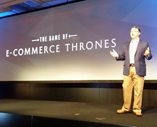 In his opening keynote at ChannelAdvisor Catalyst today, Scot Wingo said that there are six contenders battling for your business: Amazon, eBay, Google, Apple, Facebook and Alibaba.
In his opening keynote at ChannelAdvisor Catalyst today, Scot Wingo said that there are six contenders battling for your business: Amazon, eBay, Google, Apple, Facebook and Alibaba.
Some are retailers, others are third party marketplaces. Amazon’s $174 and eBay’s $83b are dwarfed by Alibaba’s $363b turnovers. However on the total number of users Facebook has 1.4b users compared with 270m Amazon users or 155 eBay users.
However these are just numbers and Scot explained it’s looking backwards – what’s interesting is to look forwards to where the companies want to be and how they’re going to get there.
Consumers
Some consumers are drive by convenience (and willing to pay for it), whilst others are value driven. You can’t appeal to everyone all of the time, although Amazon tries and, because they’ve invested so heavily, are one of the few companies able to pull it off. You need to decide for your business which type of consumer you wish to appeal to.
Another sector is Millennials, 18-34 year olds who are very elusive and moved from Facebook to Instagram to Snapchat. They don’t like to be advertised to but do appreciate peer reviews pretty much sharing everything on line from pictures of their latest meal to showing off their latest outfit, sometimes whilst still out shopping asking for advice on what to buy. This audience is the harbinger of what’s coming according to Scot – there’s another generation coming even more switched on to mobile.
Mobile
Mobile is driving tons of traffic, much of which is driven by social, the average user checks their phone 220 times spending over 3 hours a day on their smartphone. 42 minutes on Facebook, 17 minutes on twitter, 21 minutes on Instagram and another 21 minutes on Pinterest. There’s real money being driven by social, over $12bn was generated by Facebook alone in the last year. Retailers can’t afford to ignore mobile.
In China ecommerce is becoming infused into chat apps (Wechat, Snapchat, Facebook messenger etc). Chinese consumers are starting to follow brands or retailers who can them promote products to them. Retailers can also bid on keywords and when they’re used within a chat the screen turns green and you can invite the retailer into the chat who can then promote products, suggest a pair of shoes etc. That’s why Alibaba invested so much into Snapchat. ChatCommerce is coming.
Twitter on the other hand with their buy button is more suitable for flash sales and along with Facebook’s buy button are powered by Stripe. However the companies you’d expect to be great on social platforms are lagging behind according to Scot, Google (Google Plus anyone?), eBay, Amazon, Apple and Alibaba aren’t leaders in social and chat platforms are overtaking them.
Payments
Payments will become ever more important, although bizarrely eBay will be shortly without a payments platform. The interesting stat here however is that Apple have almost a billion users with a credit card on file. Although Apple Pay is relatively new, Apple users have previously registered cards with iTunes and their App Store. Potentially Apple Pay could soon have up to five times as many users with credit cards on file compared with PayPal.
Zero Friction
Zero friction is going to be key to winning customer. Amazon with 30 fulfilment centers in Europe and 100 world wide are easily the leaders. It’s by having this investment in fulfilment that they can deliver same day delivery. Retailers with click and collect are leaders, but for those that don’t are likely to fall behind. Consumers don’t always want to wait several days to get their product.
Scot sees technology such as Google maps being applied to products – if you’re driving and the road ahead is congested Google re-routes you onto a differnt road. Scot asks the question could we imagine a scenario where retailers could similarly map the future and predict which products we want and when we’ll need them in the same what that Google maps can forecast which route to our destination will be quickest.
New to the market, Jet.com plan to enable consumers to fill their basket and then retailers can bid on fulfilling that basket of products, rather than the consumer starting off browsing a single retailers site. Although they’ve not even launched yet they’ve attracted a ton of investment so this is one more trend to watch.
Cross border trade
Cross border trade is changing, global brands now launch products globally rather than country by country due to consumer demand. If they don’t consumers simply buy from overseas. Many regions are growing faster than the UK or Europe, for instance Brazil is growing at 35%, it’s a huge opportunity and is reflected by investments such as eBay’s Global Shipping Program.
Alibaba’s AliExpress is the top shopping site in both Russia and Brazil. It used to be that you’re competing with the retailer next door, but the future is going to be competing with the factories in China who list their products online cutting out all the middlemen and selling directly to consumers. However even in China there’s a growing trend for consumers to want branded goods, so commerce from the West to the Far East is likely to grow for luxury goods.
Which marketplaces will you partner with?
These are the six contenders battling for your allegiances and some of the challenges they are addressing. It’s for ecommerce retailers to decide which platforms they want to ally with and decide how to position their business for the future.










8 Responses
Where are the Aldi/Lidl of the marketplaces? At the moment it feels more like a cosy price match arrangement. Certainly not a battle.
Business is a real fight of today’s world. Its very difficult to beat our competitors. So, I am totally agree with above article.
I attended the event but I hope to get to see a replay/video of the talk!
The real value was in simplifying a complex picture and projecting forward. Not easy to do, drawing on many sources of data and a highlevel view most of us don’t get to see. Oh, and the ‘game of thrones’ analogy was a nice feature, adding humour to statistics, which can so often be dry as a subject (although in this case full of meaning for anyone in the industry).
this is the problem for retail (in any form and any product: online/offline> DVD, or cars) = Buyer is now King.
This is a problem. Now it is so easy for any customer to browse, compare and share.
The barrier to entry (enter a selling market) is the lowest ever and competition for same/ similar products is the highest ever.
It is not about “retail/ selling your wares” it is about technology.
This is a problem.
The majority do not have resources to implement the required technology and it is forever changing.
What will the future of shopping be?
Not only are we in a marker of “buyer is king” but we are still in a technological revolution so it is a combined catalyst.
notice no mention of rakuten…